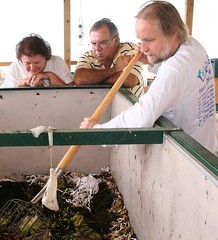One of my pet peeves is the idea that “green consumerism” alone will reverse our environmental woes. More than just “buying green,” real change will require behavioral shifts small and large.
Fortunately, composting is a relatively easy change. Chances are, you already separate your food scraps from your other waste. Composting merely requires that you set aside your food waste instead of washing it down the disposal or scraping it into the trash.
In yesterday’s post about garbage disposals, a reader asked about the specifics of composting. So let’s talk about diverting food waste from landfills and sewer lines.

For that purpose, I called on North Carolina’s composting expert, Brian Rosa. In addition to being a good friend, Brian is the Organics Recycling Specialist at North Carolina’s DPPEA.
What’s the best compost bin for beginners?
You don’t need a bin. A pile will work fine. But a bin confines the materials and is more aesthetically pleasing. If you’re in a small urban setting, the Earth Machine will work fine.
What’s the most important thing to do when composting?
Stir it and make sure there’s enough moisture. There should 60 percent moisture throughout the pile at all times. Use the “squeeze test.” If you squeeze it and it sticks together it’s right. If it crumbles it’s not right. And put all kinds of materials in there. Two browns to one green, roughly.
[WF: browns being dry organics like leaves or hay and greens being wet organics like food waste. See the ABC’s of Composting section.]
And the most important thing not to do?
Be sure not to ignore it. The more you fool with it, the more it’ll break down [i.e. decompose]. But you don’t have to mix it more than once every three or four days.
Also, don’t dump and run. If you are going to do that, keep dry stuff around—cover it with browns like paper, leaves or straw.
What about composting with worms–what kind of worm bin is best for beginners?
A 10-12 gallon tub with holes for ventilation will handle food waste from two people. You’ll need one pound of worms.
Any particular bin you’d steer people to?
Can-O-Worms is a pretty good brand. And Vermitechnologies Unlimited is a good site for buying worms.
What’s the most important thing with worms?
Keeping the bedding 12 inches deep. The bedding can be shredded newspaper (in 1 inch strips), office paper or junk mail. Just be sure to remove those plastic windows from envelopes.
Also, keeping the bedding moist (70 percent moisture). If you squeeze it and water drips, that’s right. If water doesn’t drip out, it’s too dry.
What’s the biggest worm bin no-no?
They’re pretty forgiving. You can ignore them for a long time, like I do, the poor guys. I haven’t looked at them in about a month. If it starts to smell, it’s because it’s gone anaerobic. It’s probably too wet. Stir it up or add some more dry stuff.
Any parting words (with a composting joke, please)?
Composting is both an art and a science. Most importantly, thought, you need a sense of humus.
—
Suggested Reading:
Compost This Book (well worth the quarter it costs, used)
12 Comments